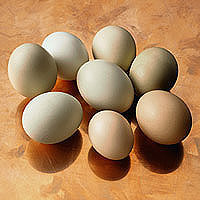Gluten Free
What does following a gluten-free diet mean? That you're embarking on an easy diet with a wide range of health-promoting effects. Instead of dwelling on what you’re giving up, consider that you’re going to enjoy a whole new world of delicious food options to meet your special dietary needs. You’ll be eating seasonally, choosing more fresh fruits and vegetables, focusing on meats, seafood, poultry, legumes, lentils, corn, and rice, and discovering fascinating ancient grains such as quinoa, amaranth, and millet. You’ll be able to eat potatoes, eggs, most cheeses, even chocolate (!)—and enjoy them without guilt because you’ll be taking good care of your body. In fact, you’ll probably end up eating—and feeling—better than ever!
Visit this page for more information about living Gluten Free
---
We carry a large variety of gluten free items, the brands listed below represent just some of the offerings we carry















More Diets
Eggs

Varieties
Grading
The U.S. Department of Agriculture (USDA) and state governments provide inspection and grading. Grade AA and A eggs are defined as eggs that hold their shape well, with tall yolks and thick egg whites. The chalaza is prominent, another sign of freshness. Grade B eggs may have flattened yolks and the white tends to be thinner; typically these eggs are used by food manufacturers, bakers, and institutions.
Size
The size of the egg is a reflection of the age, weight, and breed of the hen, with mature hens producing larger eggs. Environmental factors that lower the weight of an egg include heat, stress, overcrowding, and poor nutrition. Specific egg sizes are classified according to weight, expressed in ounces per dozen. Most recipes for baked dishes, such as custards and cakes, are based on the use of “Large” eggs.
Battery eggs
This term refers to eggs laid by chickens that are permanently caged. Although they are not required to be labeled as such, eggs are from battery-raised hens unless labeling indicates otherwise.
Brown vs. white
The color of the egg’s shell is a reflection of the breed of hen. Breeds with white feathers and ear lobes, such as White Leghorns, lay white eggs. Those with red feathers or ear lobes lay brown eggs. White eggs are in high demand among most American buyers, but in certain parts of the country, particularly New England, brown shells are preferred. Breeds that lay brown eggs include the Rhode Island Red, New Hampshire, and Plymouth Rock varieties.
Duck eggs
Duck eggs are larger than those laid by chickens, and have a higher fat content. The white tends to be more gelatinous, and the yolks are a brighter yellow. Physical characteristics of the yolk reflect both the duck’s diet and the egg’s freshness. In some cases the duck egg has a stronger flavor than a chicken’s egg. Scrambled or in omelets, duck eggs are well complemented by onions, peppers, mushrooms, or cheeses. Cooks accustomed to using duck eggs use them much like chicken eggs, taking into account their larger size. Some combine duck and chicken eggs to achieve the consistency they want in particular dishes. Professional bakers are said to prefer duck eggs because of their rich yolks and because the baked goods have better texture and hold their shape better. In Asian cuisine, duck eggs are sometimes pickled or preserved to make what are called “Thousand-Year-Old-Eggs.” Some people who are allergic to chicken eggs are able to tolerate duck eggs. Duck eggs are difficult to obtain and may be available only through specialty shops, Asian grocery stores, or by special order.
Fertile eggs
These eggs are laid by hens regularly exposed to a rooster.
Free-range eggs
Eggs labeled “free range” are laid by uncaged chickens that are permitted to exercise and move about. Under genuine free-range conditions, hens are raised outdoors or have daily access to the outside. Some egg farms are described as indoor-floor operations; in this type of environment, the hens are raised indoors, but have some freedom of movement.
Ostrich eggs
The ostrich egg is said to have been a favorite food of Queen Victoria. Each egg contains the equivalent of about two dozen chickens’ eggs. An ostrich egg weighs about 3 pounds (1,360g); it would take roughly 40 minutes to hard-boil an ostrich egg.
Quail eggs
Gourmets report that quail eggs are among the most delicious in the world. The eggs are small and fine (about 1/5 the weight of a chicken’s egg), with richly speckled shells that range in color from dark brown to blue or white. The nutritional content is comparable to that of chicken eggs, with flavor that is comparable or perhaps more delicate. Quail eggs are associated with gourmet cuisine. Some people who are allergic to chicken eggs find that they can tolerate quail eggs.
Copyright © 2025 TraceGains, Inc. All rights reserved.
Learn more about TraceGains, the company.
The information presented in the Food Guide is for informational purposes only and was created by a team of US–registered dietitians and food experts. Consult your doctor, practitioner, and/or pharmacist for any health problem and before using any supplements, making dietary changes, or before making any changes in prescribed medications. Information expires December 2025.











